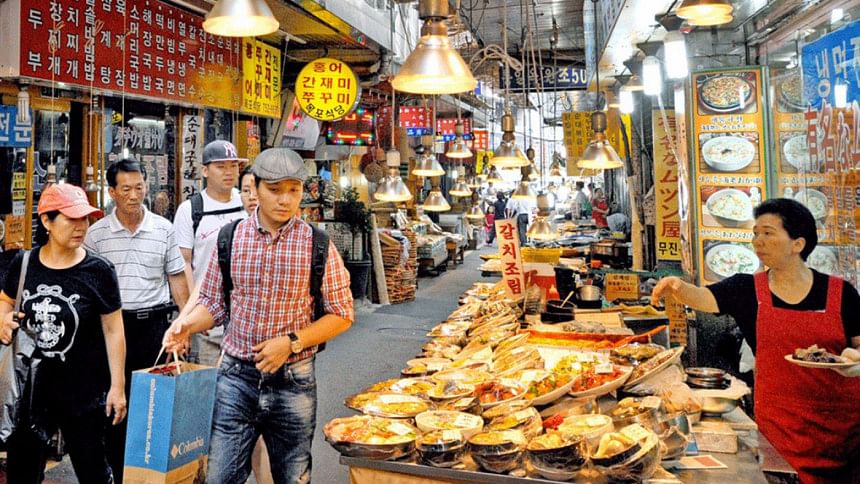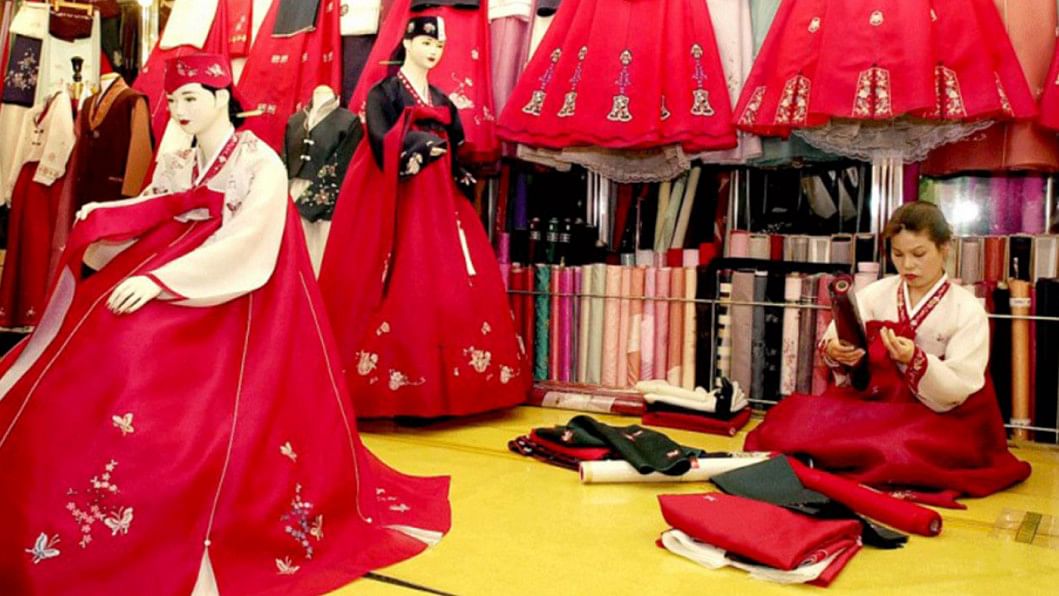The other side of Korea: Art, food and history

A group of Indonesian journalists, including The Jakarta Post, was invited by the Korea Tourism Organization to join a familiarization trip to South Korea. A number of Asian journalists and bloggers from Malaysia, Singapore, China and Japan also took part in the three-day trip.
It was raining on the day we arrived in Seoul, South Korea — a typhoon was approaching and a festival meant to welcome autumn was canceled.
In many other cities, such a situation would turn a perfectly planned holiday into an expensive misfortune. But not in Seoul, a city so vibrant that not even bad weather could spoil its charm.
If anything — especially if you're a pluviophile or do not mind getting a little wet in the rain — it actually makes the city even more charming.
In the past few years, Seoul has expanded its charm beyond its pretty parks and fancy shopping malls. It has actually been promoting its traditional markets as one of its tourist attractions.
At a glance, the idea may seem odd. Seoul, like other major Asian cities, is highly modern and urbanized. Only after visiting the markets did I find the idea plausible, if not brilliant — something that perhaps only Koreans could pull off.
The argument for the tourism strategy is quite simple. South Korea is known for many things, with K-pop and K-drama now being its biggest cultural exports. It is not uncommon for tourists (read: feverish K-pop fanboys and fangirls) to come to Seoul just to see their K-pop idols.
But Korea, an ancient civilization that has survived wars and destruction, is much bigger than boy band BTS and other K-pop sensations.
And one of the cheapest, fastest and most fun ways to learn about Korean history and culture is, of course, by visiting its remaining traditional markets.
South Korea has many historic traditional markets. In Seoul alone, there are three traditional markets that you may want to visit while you are there: Namdaemun Market, Tongin Market and Mangwon Market.
Namdaemun Market, opened in 1414, is the largest traditional market in the country, attracting more than 300,000 visitors every day. There you can find Korean art, clothes, cuisine and many other things in a single location.
If you're looking for Korean souvenirs, Namdaemun is the place. But if you like to eat but do not feel like going to a fancy restaurant or are simply on a tight budget, then Tongin Market is the place you are looking for.

The market is an alley of small shops offering traditional Korean food like bibimbap (mixed rice with meat and assorted vegetables), kimchi (fermented vegetables), gimbap (rice roll) and japchae (stir-fried glass noodles).
There you can get a tray and buy food using traditional Korean coins called yeopjeon — a simple feature that makes you feel like you are traveling back to the old days in Korea.

Other than traditional markets, South Korea has given tourists another reason to visit the country: its vibrant theater scene, especially in October, when the city's cultural center Daehak-ro holds its annual Daehak-ro festival.
The Korean performing arts scene had developed way before K-pop and K-drama grabbed global attention, producing many talents that have made Seoul one of the leading art and cultural centers in Asia today.
During our trip, we had the chance to watch two plays in Daehak-ro: Only You, a popular musical filled with 1990s Korean hits, and Finding Mr. Destiny, which was adapted into a rom-com in 2010. We also had the chance to watch the epic play 1446 at Theater Yong at the National Museum of Korea.
Wait, are you wondering if I speak Korean? No, I do not. Some theaters in Seoul provided English, Chinese and Japanese translations for foreign audience members.
While the subtitles might not capture the nuances of the dialogue, they still let you follow the important parts of the play even if you do not understand the language. It also gives you some of the funniest lines, though not all of them, since at some parts you could hear the rest of the audience laughing without you.

On the last two days of our trip in Seoul, the sky was clear. We took a city tour with the Artee Riders Club, which takes tourists on a rickshaw ride into the popular attractions in Seoul, including its historical villages and alleys.
The 60-minute tour ended at Gyeongbok Palace, where many Koreans could be seen strolling in their beautiful traditional dress, called hanbok. A rickshaw tour is perhaps shorter than a bus tour, but it could give you a more intimate picture of Seoul, as told by an English-speaking driver who knows the city's history.
A city tour in Seoul is nice. But if you are a food or musical lover, the city is certainly best experienced in many of its traditional markets and theater halls.
Daehak-ro Street the mecca of plays
Daehak-ro Street is widely known as "the mecca of performance arts", "Korea's Broadway" and a "symbol of Korean youth and culture".
For decades, it has served as Seoul's cultural center. In Korean, Daehak-ro means "College Street". It was given the moniker as it used to be the headquarters of Seoul National University — which included its College of Liberal Arts and Science and College of Law — before the university relocated its campuses.
The area is now home to 160 performance halls. It holds, according to the Korean Tourism Organization (KTO), four times the number of theaters than New York's Broadway and three times that of London's West End.
For Indonesian tourists, the area would perhaps remind them of Jakarta's own cultural center, Taman Ismail Marzuki (TIM). It is more or less the same as TIM, only bigger and way more vibrant with many shows throughout the year.
October, however, is the best time to visit Daehak-ro. Throughout the month, the KTO organizes Welcome Daehak-ro, a festival in which foreign tourists can enjoy a number of musicals and plays with English subtitles.
Some of the most popular musicals are Finding Mr.
Destiny, Love Comes with the Rain, Oh! While You Were Sleeping, Only You, Laundry and 1446. The ticket prices range from 15,000 won (US$13.22) to 60,000 won.
Some performances, such as Finding Mr.
Destiny and Only You, are shown in small theater halls where the artists can interact with the audience.
During these shows, you cannot help but envy the local audience, because there is improvised dialogue without subtitles that always draws laughter.
Outside the halls, at Marronnier Park, some amateur artists, mostly musicians or hip-hop dancers, usually perform for free. During Welcome Daehak-ro festival, some non-verbal performances are also shown at the park.
No subtitles are provided for outdoor performances, of course, but they are still enjoyable. After all, millions of people around the world have been drawn to K-pop, even if they only know one or two Korean words.
Choose your traditional Korean markets
Traditional markets can be found in all provinces in Korea. The Korean Tourism Organization has listed at least 17 top traditional markets that you can choose to visit while in the country.
Among them are Cunccheon Jungang (Nangman) Market in Gangwon-do, Suwon Nammun Market in Gyeonggido, Singi Market in Incheon, Seomun Market in Daegu and 1913 Songjeong Station Market in Gwangju.
Each market has its own unique features. Singi Market, for instance, operates a unique payment system where buyers can use special coins called singi tongboto pay for certain merchandise.
Seomun Market is one of the largest and most historic markets in Korea. It goes back to the age of the Joseon dynasty.
The market's main products are textile goods and hanbok traditional costumes, but it has recently been known for its night market, which offers treats like napjakmandu (flat dumplings) and tteokbooki (spicy stir-fried rice cakes).
Nangman market, meanwhile, is known for its romantic atmosphere. Chuncheon itself is known as the "City of Romance". The city is especially known for being the filming location of the 2002 K-drama classic Winter Sonata and the city's romance theme can be found even in one of its traditional markets.

We had the chance to visit Nangman Market on the second day of our trip. Located just one hour away from Seoul, the market has stores that are decorated with drawings that lend a fun twist, preventing the space from feeling somber. If you explore deeper into the market, you will find various sculptures and wall murals, adding to the creative vibe of the place.
But do not forget that Nangman Market is still a market where you can find various products ranging from daily necessities to hanbok, bags, shoes, clothes, electronic appliances, jewelry and food.
A wide range of people, whether locals or foreign tourists, go there to shop.

 For all latest news, follow The Daily Star's Google News channel.
For all latest news, follow The Daily Star's Google News channel. 




Comments